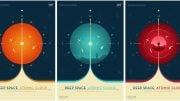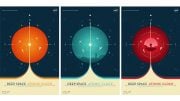
Astronomical observations suggest that dark matter, comprising over 80% of all matter, only interacts gravitationally with visible matter. Researchers at PTB used sensitive atomic clocks to seek evidence of ultralight dark matter affecting the fine-structure constant, but found no significant changes, refining our understanding of its potential interactions and the stability of the constant over time.
Comparisons between optical clocks at PTB bolster the quest to detect potential interactions between ultralight dark matter and photons.
Observations in astronomy suggest the presence of “dark matter,” accounting for over 80% of all matter. To our current understanding, it primarily interacts with visible matter through gravitational forces. Notably, there’s no established evidence that it interacts with photons, the fundamental particles that also form light. This lack of interaction is why it’s termed “dark.” The composition of dark matter and any potential unknown interactions with regular matter continue to be intriguing puzzles.
A particularly promising theoretical approach implies that dark matter could consist of particles that are extremely light and behave more like waves than individual particles: so-called “ultralight” dark matter. In this case, previously undiscovered, weak interactions of dark matter with photons would lead to minuscule oscillations of the fine-structure constant.
The fine-structure constant is the natural constant that describes the strength of the electromagnetic interaction. It determines the atomic energy scales and thus influences the transition frequencies that are used as references in atomic clocks. Since different transitions are sensitive to possible changes of the constant to varying degrees, comparisons of atomic clocks can be used to search for ultralight dark matter. For this purpose, researchers at PTB have now used an atomic clock that is particularly sensitive to possible changes of the fine-structure constant in such a search.
For this purpose, this sensitive atomic clock was compared with two other atomic clocks with lower sensitivities in months-long measurements. The resulting measurement data were investigated for oscillations, the signature of ultralight dark matter. Since no significant oscillations were found, the dark matter remained “dark“, even under closer examination.
Detection of the mysterious dark matter was therefore not achieved. The absence of a signal allowed for the determination of new experimental upper limits on the strength of a possible coupling of ultralight matter to photons. Previous limits were improved by more than one order of magnitude over a wide range.
At the same time, the researchers also studied whether the fine-structure constant might change over time, for example by increasing or decreasing very slowly. Such a variation was not detected in the data. Here, existing limits were also tightened, indicating that the constant remains constant even over long periods of time.
In contrast to previous clock comparisons, where each atomic clock required its own experimental system, two of the three atomic clocks were realized in a single experimental setup in this work. For this purpose, two different transition frequencies of a single trapped ion were used: The ion was interrogated alternately on both optical transitions. This is an important step towards making optical frequency comparisons even more compact and robust – for example, for a future search for dark matter in space.
Reference: “Improved Limits on the Coupling of Ultralight Bosonic Dark Matter to Photons from Optical Atomic Clock Comparisons” by M. Filzinger, S. Dörscher, R. Lange, J. Klose, M. Steinel, E. Benkler, E. Peik, C. Lisdat and N. Huntemann, 22 June 2023, Physical Review Letters.
DOI: 10.1103/PhysRevLett.130.253001








According to topological vortex gravitational field theory, dark matter are codimension-two defects in an ordered medium. If it can be detected in scientific research, it should have already changed its state with the detection. At this point, it may no longer be called dark matter.
So, yet another idea with no results.
Another possibility, from a view of String Theory, is that Dark Matter appears to us as an effect of string/anti-string annihilations. As you may know, quantum mechanics requires that strings must be formed as pairs in the quantum foam – a string and an anti-string – that immediately annihilate each other. Quantum mechanics also requires both the string and anti-string to be surrounded by “jitters” that reduce their monstrous vibrating energies. What if this jitter remains for a fraction of an instant after their string/anti-string annihilations? This temporary jitter would be seen by us as matter, via E=mc2, for that instant before it too returns to the foam. That’s why we never see it – the “mass” lasts only for that instant but is repeated over and over and over, all over. Specifics on this can be found by searching YouTube for “Dark Matter – A String Theory Way”
According to topological vortex gravitational field theory, gravitation is the source of all things and the most essential force to maintain and connect the world. Any many-body dynamics theory that does not involve gravitation may be incomplete, such as String Theory.
As a scholar, have you ever asked yourself: Where does the power of the particles and celestial body spin come from? Will mathematics inspire you? Can topological vortices not spin? Is the spin of topological vortices related to gravitation?
If you are interested, you can browse https://arxiv.org/ftp/astro-ph/papers/0410/0410365.pdf.
String Theory is a general variation of quantum gravity theory. Einstein showed that gravity is a result of the curvature of space by mass and is very weak. I still think the possibility of string parts temporarily left during annihilation may provide an answer to the Dark Matter question.
Mathematics does not support topological vortices being slightly more than their antivortices. However, String Theory imagined by so-called scientists think that the possibility of string parts temporarily left during annihilation may provide an answer to the Dark Matter question. As for gravity, they have confidence that God will give the answer. Please continue to imagine.
Good luck to you.
A possibility, one that has already been theorized (SVT and DMS), is that excess mass/gravity is a result of deep space superfluid, which would be extremely hard to detect since particles (including photons) would flow without loss (no entropy, no viscosity) but it would have mass. It is at least intriguing, given the vortices that spiral galaxies seem to mimic. This would not be the same as the old Aether model. If we assume that there is a superfluid dark matter, it does not necessarily need to be prolific. It could be clumpy, or perhaps form as mega-flows (superfluid vortex dynamics at a very large scale) in the voids between solar systems (which would also explain some of the odd radial velocities of spiral galaxies). If we were to propose a map of the flows, with boundaries based on Lambda point differentials (which flow between solar heat points), perhaps we could devise an experiment to detect a hypothetical pattern. If this idea were true, we would literally have rivers in the heavens.
Why turn a blind eye to vortex. Even if you remove all the planets in the solar system, a vortex centered around the sun still exists.